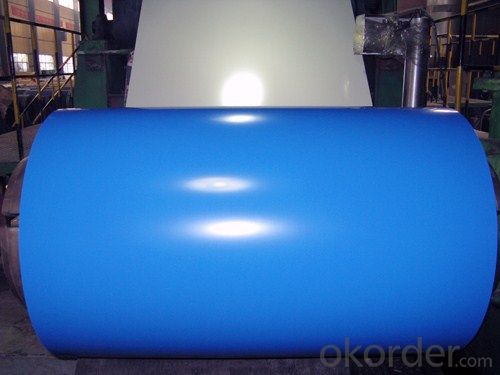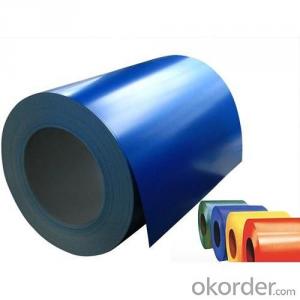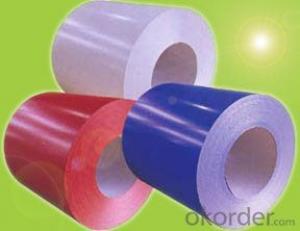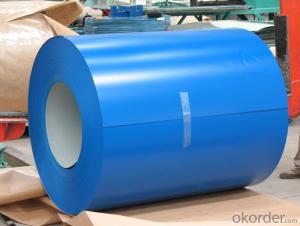THE PRE-PAINTED GALVANIZED STEEL COILS
- Loading Port:
- China Main Port
- Payment Terms:
- TT OR LC
- Min Order Qty:
- -
- Supply Capability:
- -
OKorder Service Pledge
OKorder Financial Service
You Might Also Like
Painting steel isthe product based on the metal sheet, of which surface is finally installed ofthe plastic film(PVC, PE) IN addition to being firstly covered with the coatingand printed ink in. The coated layer of painting steel plate consists of chemicaland filming layer, primer coated layer, pattern printed layer and surfacecoated layer. The top and back coating shall generally be the weatherproofpaint, as well can be the application of the paint with special capabilitiessuch as stain-resistant, self cleaning capability, high thermal resistance,antistatic capability, sterilizing capability, finger-print prevention and etc.
With GI(aluzinc) asbase metal, after pretreatement(degrease and chemical treatment)and liquid dopewith several layers of color, then after firing and cooling, finally the platesteel is called pre-painted galvanized (aluzinc)steel. Pre-painted galvanized steelis good capable of decoration, molding, corrosion resistance. It generallydisplays superior workability, durability and weather resistance.
Availablespecification:
PAINTING STEEL | |
BASE MATERIAL | HDGI, ALUZINC,CR |
GRADE | SGCC, DX51D,ASTMA653,EN10142,S350GD |
THICKNESS | 0.17-1.0mm |
WIDTH | 600-1250mm |
ZINC COATING | 60-200g/㎡ |
PAINT | PE,PVDF,SMP,HDP |
COILED | 508mm |
COIL WEIGHT | 3-6mt |
We can supply customers' with different specifications of the highest quality and lowest price.
Sincerely welcome to contact us for the future details if any item interest you ,and we will make every effort to assure that your requirements will be satisfied ,and we hope to establish long-term business relations with you on the basis of the equality and mutual benefit.
We are waiting for your email.
- Q: How are steel coils used in the production of food processing machinery?
- Steel coils are used in the production of food processing machinery as they are commonly used to create the structural frames and components of the machinery. Additionally, steel coils are often used to manufacture cutting blades, conveyor belts, and various other parts that require strength and durability in the food processing industry.
- Q: also what are the factors of location of these steel plants
- A lot of iron ore is available in the upper great lakes region. Iron ore needs to be transported on large freighters, and the Great lakes served a purpose for that transit system as well. I cant say much about Birmingham, but as for Detroit and Pittsburgh, the steel forming industry has been greatly affected by the low cost Asian imports now available. I think what happened was this: The US used to subsidize the US steel industry, this kept prices artificially high ( compared to the world market ), but also kept the plants open. Sometime during the present Bush administration, the US stopped subsidizing the steel industry, and the Asian steel manufacturers started dumping steel here in the US at very low prices, this caused the US company's to stop or greatly lower their production, and many US steel plants went out of business. Now with the US steel companies out of the way, the Asian steel companies have steadily raised their prices on the US steel buyer. Hows that for fair trade, the steel industry isn't the only thing this has happened to either. I know this was a bit of a rant, but I wanted to point out how a once proud steel industry was put to death by politics.
- Q: I'm a hiker and cook on a camp fire with a canteen cup. So which would be a better material for cooking on a campfire with, aluminum or stainless steel?
- Stainless steel. And you do NOT have to ruin the pan on a campfire. Carry some liquid dishwashing liquid (which you will want anyway). BEFORE putting the pan onto the fire, smear some dishwashing liquid on the OUTSIDE of your pan: bottom AND the sides. As the pan sits on the fire, the SOAP will blacken and soot up instead of the pan. When you wash the pan, the soot slips off with the soap you applied beforehand. If you don't coat the outside of your pan with dishwashing liquid, it will soot up and the soot does not wash off.
- Q: What are the different steel coil surface treatments?
- There are several different steel coil surface treatments available, including hot-dip galvanizing, electro-galvanizing, chromate-free treatment, and organic coating. Each treatment provides different benefits and protection against corrosion and other environmental factors.
- Q: i wanna buy a sharp carbon steel sword the swords i want are a 200 layer carbon steel katana or a hand forged high carbon steel katanna or a hand sharpened sword which one would be sharper/stronger
- You need to be very careful when selecting a sword. Most f the sellers are lying about their swords. If we were talking about tow 400 year old swords you could bet that the folded steel blade would be the better. Today many rip-off sellers put that in the advertisement to get people that don;t know any better to buy their sword. Many new swords that are not folded are as good or better then folded. your best bet is to buy only from a reputable seller. There are two I know sell good swords Bugei Trading and Cheness. I like cheness because the swords are reasonable in price and very well made. Expect to spend at least $220 to get anything worth buying. Cheness has a line of swords Katana that are made of spring steel. Note: carbon steel varies greatly depending on the exact steel used, it carbon content (how much carbon), and how the sword is made and tempered. Many of the rip-off swords are made of carbon steel, just low quality steel and bad workmanship. ...
- Q: How are steel coils inspected for bendability?
- Steel coils are inspected for bendability through a combination of visual examination, mechanical testing, and dimensional analysis. Visual inspection involves identifying any visible defects such as cracks, dents, or surface irregularities that could affect the coil's bendability. Mechanical testing is conducted to measure the coil's resistance to bending and evaluate its flexibility. This includes performing bend tests to determine the coil's ability to withstand a specified degree of bending without breaking or cracking. Additionally, dimensional analysis is performed to ensure that the coil meets the required thickness, width, and length specifications, as these factors also impact its bendability.
- Q: and is that different from the components of steel
- Making steel is very energy intensive. Mining the raw ore requires a lot of machinery that uses fuel or electricity . Transporting the ore requires a lot of fuel. Refining not only uses a lot of electricity but coal is added to change the iron ore into steel.
- Q: Steel coil from vertical to horizontal, what sling needs?
- The sling has little effect, but it is easy to damage the surface of rolled steel.
- Q: What are the different types of steel coils?
- There are several different types of steel coils, including hot-rolled coils, cold-rolled coils, galvanized coils, and stainless steel coils.
- Q: What are the pros and cons of non-stick and stainless steel pots and pans ?Thanks
- Non stick doesnt stick but after time the non stick doesnt stay non stick and then time to replace Stainless steel. some things may not stick but its best to put down a little pam, or cooking oil, and or aluminum foil
Send your message to us
THE PRE-PAINTED GALVANIZED STEEL COILS
- Loading Port:
- China Main Port
- Payment Terms:
- TT OR LC
- Min Order Qty:
- -
- Supply Capability:
- -
OKorder Service Pledge
OKorder Financial Service
Similar products
Hot products
Hot Searches
Related keywords






























